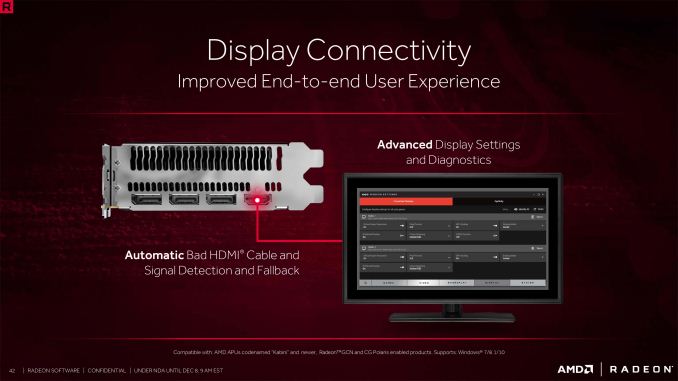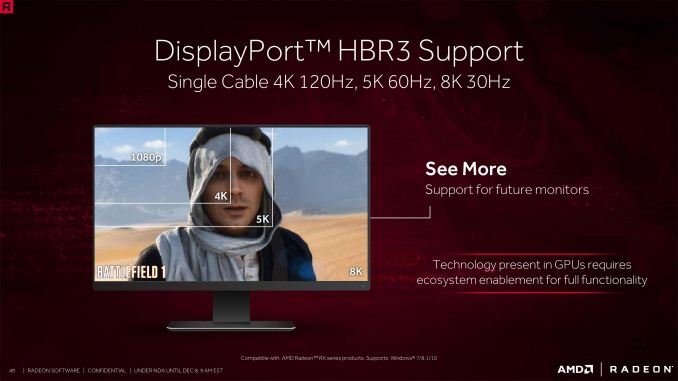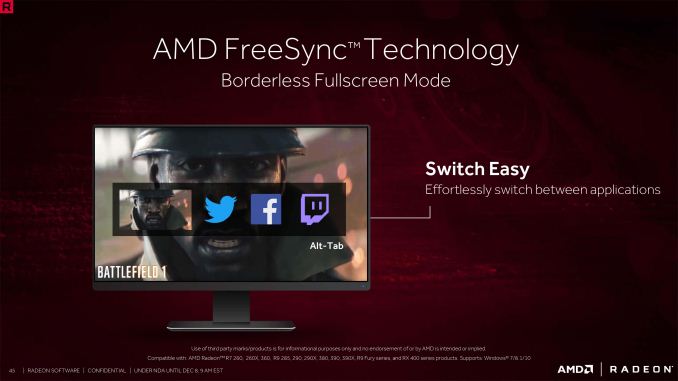AMD Delivers Crimson ReLive Drivers: Yearly Feature Update for Radeon Gamers and Professionals
by Ian Cutress on December 8, 2016 9:00 AM ESTReLive New Features (2)
Display Diagnostics
One of the most frustrating things to diagnose with a display that will not turn on is the cable. I’ve been there, in an overclocking content, having changed CPU/GPU/Motherboard/Monitor/DRAM over the course of two hours only to find that the cable between my machine and the monitor had died. There’s no indication that the cable was ever failing, and no light to say it was/wasn’t working.
I’m not the only one to have had this issue, apparently. AMD told a story of how their CEO of the Radeon Technology Group (RTG), Raja Koduri, had a similar issue trying to connect an HTPC to his TV. After many emails around the company, troubleshooting fresh OS installs and BIOS updates, the culprit was the HDMI cable, and despite the fact it had been used before was fine, but it had gone the way of the dodo.
With this in mind, AMD has created a set of display diagnostics in Crimson ReLive for HDMI. On all AMD APUs from Kabini and all GCN discrete GPUs, the software can detect a bad HDMI cable and realign the signal for both resolution and frequency to get to a point where the signal is stable.
This can help in most situations (short of a severed cable) by widening the window for bad data to be accepted at a loss of frame rate or resolution. At present this feature is only for HDMI ports on relevant cards, but when a bad cable is detected and a display has to change to work, the software notifies the user that a new cable is needed.
VP9 Decode and HDR10/HBR3 Support
One of the issues with last year’s launch of Crimson is that most of the video display settings seemed to not work with streamed video, particularly VP9 video coming from YouTube. This is in part due to VP9 decode not being supported on AMD products, but with the ReLive driver this changes. ReLive will allow for 4K60 decode of a VP9 stream for all GCN enabled discrete graphics cards and Stoney Ridge APUs. This is ultimately a software solution using the GPU, so it isn’t as power efficient as a dedicated hardware solution, but does offer a lot more performance than a CPU.
On the HDR front, AMD has been promoting that high end R9-300 series and RX-400 series graphics cards can support HDR10, however this has not been enabled in the drivers until Crimson ReLive. All the demos seen at AMD shows up to this point on compatible HDR10 displays have been beta driver versions specifically not released to the public, however with ReLive this changes. This also pairs with DisplayPort HBR3 support being enabled with ReLive allowing for 4K120, 5K60 and 8K30 over a single cable (HBR3 is on RX-series only).
FreeSync: Borderless Fullscreen Mode and Refresh Ramping
One of the most requested features for AMD has been bringing FreeSync into other modes than just single-focus full-screen mode. This is particularly important for users that use multiple monitors and end up requiring other content on a second monitor while the first is running, or for other applications to take focus quickly. With ReLive, AMD has put the tools in place to enable Borderless Fullscreen mode for software that can use it. One of the issues moving away from a fullscreen fixed mode is the click-to-response time latency, which AMD claims to have reduced by up to 24%.
Refresh Ramping will be another feature in ReLive and is designed to stop harsh changes in panel refresh rate depending on the content. When the onscreen display can run at a lower refresh rate, rather than slamming down immediately to that rate, the driver will pull the refresh rate down over a few seconds in order to give a smoother transition, and similarly to a higher refresh rate. AMD states that this saves power, which without data might be correlated to the actual switching of refresh rate rather than the low refresh rate itself.













48 Comments
View All Comments
PseudoKnight - Thursday, December 8, 2016 - link
"took a few seconds..." cracked me uplol, now i'm imagining you starting up your download manager just in case your sister makes a phone call and you have to resume the download later.
A5 - Thursday, December 8, 2016 - link
It's possible the board designs spec a different HDMI/DP chip that supports it or something.Probably just a testing or marketing thing though.
Colin1497 - Thursday, December 8, 2016 - link
Yeah, I have a box with a 285 in it (my son's). Doesn't have an appropriate monitor today, but the monitor is the next thing to get replaced, so it was personal interest driving the Q. :)Manch - Thursday, December 8, 2016 - link
Was wondering the same thing. Why the rebadge only. Ill start the download :D as soon as I get home. Then I'm requesting the feature for my 290X'snathanddrews - Thursday, December 8, 2016 - link
The only differences over Hawaii that I know of are that Grenada has refined power delivery, power management, and faster 6 GHz VRAM. Pretty sure that Grenada and Hawaii share the same encode/decode blocks and display outputs, but it's possible that Grenada shipped with higher speed DisplayPort ports and it was never published due to the lack of concrete validation methodology at the time, but I doubt it. Pretty sure AMD/NVIDIA just buy DP/HDMI port hardware/controllers in bulk and order whatever is available at the time.Technically, HDR10 metadata can be streamed using older display connections (just like Dolby Vision), but without monitor/TV support, I'm curious to what AMD has planned. My guess is HDR10 will be limited to 8-bit Rec.709 on Grenada, whereas Polaris will get support for HDR10 10-bit Rec.2020, based upon port capabilities alone.
Why TongaXT is included in the mix and not Hawaii, I don't know.
testbug00 - Sunday, December 11, 2016 - link
Tonga is GCN gen3, Hawaii is GCN gen2.Gen1=Cape Verde, Pitcairn, Tahiti.
Gen2= Bonaire, Hawaii
Gen3= tonga, Fiji
Gen4= P11, P11
There is orland and I think one more 28nm GPU, but I do not know if they are gen 1, 2 or 3z
R3MF - Thursday, December 8, 2016 - link
"On the HDR front, AMD has been promoting that high end R9-300 series"What is it about a 390 series card that is absent in the 290 series card, to make the former compliant with HDR when the latter is not?
Is this purely HDR10 support, or does it include Dolby Vision as EA have said Mass Effect Andromeda will use on the PC? If not, do AMD think this matters?
ET - Thursday, December 8, 2016 - link
Hardware compatibility looks incomplete. It makes no sense for example that user feedback isn't available on APU's, or that VP9 4K60 works on discrete and Stoney Ridge but not on Bristol Ridge.R3MF - Thursday, December 8, 2016 - link
Re: Linux supportDoes "SLED/SLES 12" support indicate there will be a driver compatible with Opensuse Leap 42.2?
PseudoKnight - Thursday, December 8, 2016 - link
I really appreciate AMD adding features and improvements to even their five year old cards (own a 3 year old card). I've also liked this new direction they've been taking with their software since Crimson. It never felt quite finished (with some things being tacked on) but this looks like it might finally rounds things out. I'm particularly looking forward to testing out ReLive DVR. I suspect I'll stick with OBS Studio, but here's hoping it surprises me.